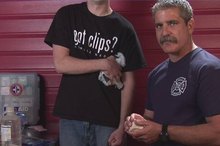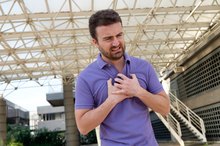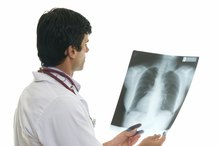Symptoms of Torn Cartilage in the Ribs
Your rib cage includes both bone and cartilage, a firm tissue that is more elastic than bone. Cartilage is attached to the front portion of your ribs and allows your chest to expand as you move and breathe. But your ribs and associated cartilage have limited flexibility. Trauma to, or overstretching of, the junction between the bones and cartilage of your rib cage can cause a tear. Pain is the predominant symptom. Seek medical attention if you suspect a torn rib cartilage, as there may be additional damage to your rib cage or organs within your chest cavity.
If you are experiencing serious medical symptoms, seek emergency treatment immediately.
Localized Pain
Torn cartilage in the ribs is usually very painful. Sharp pain typically occurs immediately at the site of the tear. Ongoing pain may persist for weeks to months, depending on the severity of the injury. Your doctor may recommend an over-the-counter or prescription pain reliever to reduce your discomfort. In some cases, your doctor may inject anti-inflammatory and pain-relieving medications directly into the injured area. For the first few days after the injury, applying a cold pack for 15 minutes every 3 to 4 hours may help reduce the pain. After 72 hours, heat may be applied for 15 to 20 minutes every few hours to promote healing by increasing blood flow in the affected area.
- Torn cartilage in the ribs is usually very painful.
- In some cases, your doctor may inject anti-inflammatory and pain-relieving medications directly into the injured area.
Movement-related Discomfort
Ribs Cracking and Stretching
Learn More
Your diaphragm -- the main muscle used for breathing -- attaches to your lower ribs. As a result, simple movements such as breathing, coughing or sneezing may provoke or increase pain caused by a rib cartilage tear. Other everyday movements that involve twisting or expansion of your rib cage may also cause pain. Holding a pillow against your chest may make these movements less painful 3. Your doctor may advise you to see a physical therapist, who can instruct you how to move and gradually return to normal activity without aggravating your pain.
- Your diaphragm -- the main muscle used for breathing -- attaches to your lower ribs.
- Holding a pillow against your chest may make these movements less painful 3.
Other Symptoms
Bruising is likely in the affected area when a rib cartilage tear is caused by a forceful blow to your chest. Localized swelling would also be common in this situation. You may notice clicking, popping or grinding at the site of your rib cartilage tear, especially when you take a deep breath. Your breathing may be slightly more shallow than normal as you instinctively try to minimize your pain by avoiding deep breathing.
- Bruising is likely in the affected area when a rib cartilage tear is caused by a forceful blow to your chest.
Warnings
Symptoms of a Broken Sternum
Learn More
Injuries to your rib cage can be serious, so it's important to see a doctor if you sustain any rib-related injury. Multiple ribs can be involved, which may jeopardize your ability to breathe. You also need to be examined to make sure your internal chest organs have not been injured. Additionally, heart disease can cause chest pain similar to that associated with a rib cartilage tear. Seek emergency medical care if you experience difficulty breathing or chest pain that is not associated with an injury -- especially if accompanied by sweating, nausea, dizziness, arm pain or jaw pain.
Reviewed by Mary D. Daley, MD.
- Injuries to your rib cage can be serious, so it's important to see a doctor if you sustain any rib-related injury.
Related Articles
References
- Forensic Medicine With Dr. Cox, M.D.: Blunt Force Traumatic Injuries of the Chest
- American Family Physician: Costochondritis -- Diagnosis and Treatment
- Critical Care Medicine: Management of the Crushed Chest
- Rice University. 7.4 The Thoracic Cage – Anatomy and Physiology. Opentextbc.ca. https://opentextbc.ca/anatomyandphysiology/chapter/7-4-the-thoracic-cage/
- KidsHealth from Nemours. Your bones.
- U.S. National Library of Medicine. MedlinePlus. Bruised rib care. Updated June 2019.
- American Society of Regional Anesthesia and Pain Medicine. The Slipping Rib Syndrome: An Often-Overlooked Diagnosis. February 2019.
- Copeland G, MacHin D, Shennan J. Surgical treatment of the ‘slipping rib syndrome’. British Journal of Surgery. 1984;71(7):522-523. DOI:10.1002/bjs.1800710716
- Heinz G. Slipping Rib Syndrome. JAMA. 1977;237(8):794. DOI:10.1001/jama.1977.03270350054023
- Meuwly J, Wicky S, Schnyder P, Lepori D. Slipping Rib Syndrome. Journal of Ultrasound in Medicine. 2002;21(3):339-343. DOI:10.7863/jum.2002.21.3.339
- Rice University. 7.4 The Thoracic Cage – Anatomy and Physiology. Opentextbc.ca.
Writer Bio
Aubrey Bailey has been writing health-related articles since 2009. Her articles have appeared in ADVANCE for Physical Therapy & Rehab Medicine. She holds a Bachelor of Science in physical therapy and Bachelor of Arts in psychology from the University at Buffalo, as well as a post-professional Doctor of Physical Therapy from Utica College. Dr. Bailey is also a certified hand therapist.







